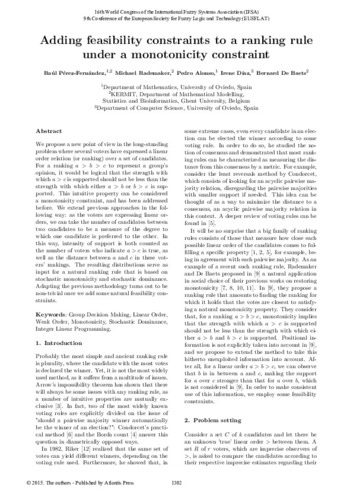Adding Feasibility Constraints to a Ranking Rule under a Monotonicity Constraint
Autor(es) y otros:
Fecha de publicación:
Resumen:
We propose a new point of view in the long-standing problem where several voters have expressed a linear order relation (or ranking) over a set of candidates. For a ranking a > b > c to represent a group’s opinion, it would be logical that the strength with which a > c is supported should not be less than the strength with which either a > b or b > c is supported. This intuitive property can be considered a monotonicity constraint, and has been addressed before. We extend previous approaches in the following way: as the voters are expressing linear orders, we can take the number of candidates between two candidates to be a measure of the degree to which one candidate is preferred to the other. In this way, intensity of support is both counted as the number of voters who indicate a > c is true, as well as the distance between a and c in these voters’ rankings. The resulting distributions serve as input for a natural ranking rule that is based on stochastic monotonicity and stochastic dominance. Adapting the previous methodology turns out to be non-trivial once we add some natural feasibility constraints
We propose a new point of view in the long-standing problem where several voters have expressed a linear order relation (or ranking) over a set of candidates. For a ranking a > b > c to represent a group’s opinion, it would be logical that the strength with which a > c is supported should not be less than the strength with which either a > b or b > c is supported. This intuitive property can be considered a monotonicity constraint, and has been addressed before. We extend previous approaches in the following way: as the voters are expressing linear orders, we can take the number of candidates between two candidates to be a measure of the degree to which one candidate is preferred to the other. In this way, intensity of support is both counted as the number of voters who indicate a > c is true, as well as the distance between a and c in these voters’ rankings. The resulting distributions serve as input for a natural ranking rule that is based on stochastic monotonicity and stochastic dominance. Adapting the previous methodology turns out to be non-trivial once we add some natural feasibility constraints
Descripción:
IFSA-EUSFLAT'2015: 16th World Congress of the International Fuzzy Systems Association and 9th Conference of the European Society for Fuzzy Logic and Technlogy, July 2015, Gijón, Spain
Patrocinado por:
This work has been partially supported by Campus of International Excellence of University of Oviedo
Colecciones
Ficheros en el ítem




